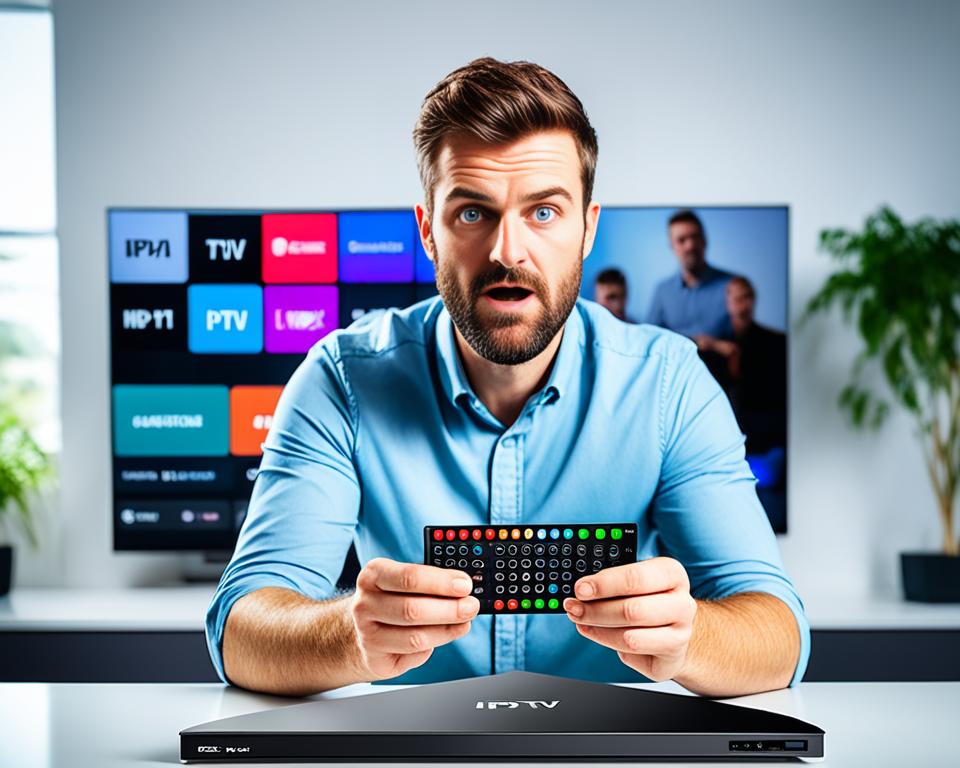Did you know that IPTV (Internet Protocol Television) is revolutionizing the way we consume video and audio content? With its ability to deliver media over IP networks, such as the internet, IPTV has become increasingly popular among viewers worldwide. However, ensuring optimal streaming quality and connectivity can be a complex task, especially in low-bandwidth networks.
In this article, we will explore expert tips and best practices for optimizing IPTV streaming quality and enhancing connectivity. Whether you are a content provider or a viewer, these tips will help you improve your IPTV viewing experience and overcome common challenges. From choosing the right encoding format to troubleshooting slow IPTV issues, we’ve got you covered.
Key Takeaways:
- Choose the right encoding format to balance video quality and bandwidth consumption.
- Utilize adaptive bitrate streaming techniques to optimize the video stream for varying network conditions.
- Implement caching and edge computing strategies to reduce latency and improve response time.
- Optimize the network infrastructure and configuration, considering network capacity, reliability, security, and quality of service.
- Troubleshoot common IPTV issues and improve performance by checking internet speed, clearing cache, and updating firmware.
Choose the Right Encoding Format
The encoding format used for IPTV content is crucial for its quality and performance. Different encoding formats, such as MPEG-2, MPEG-4, H.264, and HEVC, offer varying levels of compression and bandwidth consumption.
MPEG-2 is a widely used format known for its compatibility but requires more bandwidth compared to newer formats.
MPEG-4 is an advanced format that provides better compression, resulting in improved bandwidth efficiency while maintaining good video quality.
H.264, also known as Advanced Video Coding (AVC), offers high-quality video compression with moderate bandwidth consumption. It is widely used for IPTV streaming due to its efficiency.
HEVC (High-Efficiency Video Coding), also known as H.265, is the most advanced video compression format available. It provides superior compression, significantly reducing bandwidth consumption while maintaining excellent video quality.
The choice of encoding format depends on various factors such as content requirements, network conditions, and device compatibility. It is essential to assess the trade-offs between video quality and bandwidth consumption before selecting the most suitable encoding format.
Comparison of IPTV Encoding Formats
| Encoding Format | Compression | Bandwidth Consumption |
|---|---|---|
| MPEG-2 | Less efficient | Higher |
| MPEG-4 | Moderate efficiency | Moderate |
| H.264 | High efficiency | Moderate |
| HEVC (H.265) | Superior efficiency | Lower |
Use Adaptive Bitrate Streaming
Adaptive bitrate streaming (ABR) is a technique that revolutionizes video streaming by adjusting the bitrate and resolution of the video stream according to the available bandwidth and device capabilities. With ABR, viewers can enjoy uninterrupted streaming without buffering or pixelation, regardless of their network conditions.
ABR employs various adaptive bitrate streaming techniques, such as HLS (HTTP Live Streaming), DASH (Dynamic Adaptive Streaming over HTTP), and Smooth Streaming. These protocols and standards ensure smooth and efficient streaming, optimizing the viewing experience for users.
One of the key advantages of ABR is that it automatically adjusts the video bitrate and resolution in real-time, based on the viewer’s network conditions. If network congestion occurs or the available bandwidth decreases, ABR will dynamically lower the bitrate and adjust the resolution to maintain a seamless streaming experience. Conversely, if the network conditions improve, ABR will adaptively increase the bitrate and enhance the resolution, delivering the best possible quality.
By implementing ABR, content providers can deliver a consistent and high-quality viewing experience to audiences with varying network conditions. Whether it’s a viewer with a slow internet connection or a user on a reliable high-speed network, ABR ensures that everyone can enjoy the content without interruptions or quality degradation.
To visualize the benefits of adaptive bitrate streaming, take a look at the table below that demonstrates how ABR adjusts the bitrate and resolution based on network conditions:
table {
width: 100%;
border-collapse: collapse;
}
th, td {
border: 1px solid black;
padding: 10px;
text-align: center;
}
| Network Conditions | Bitrate | Resolution |
|---|---|---|
| Poor | 500 kbps | 480p |
| Medium | 1 Mbps | 720p |
| Good | 5 Mbps | 1080p |
As depicted in the table, ABR dynamically adjusts the bitrate and resolution to match the viewer’s network conditions. This ensures that the streaming quality remains optimized, delivering the best possible experience for users, no matter their network limitations.
In conclusion, adaptive bitrate streaming is a game-changer for video streaming, allowing viewers to enjoy a seamless and high-quality experience by adapting to their network conditions. By leveraging ABR techniques like HLS, DASH, and Smooth Streaming, content providers can deliver optimized streams that cater to varying bitrate and resolution requirements. ABR eliminates buffering, pixelation, and interruptions, providing viewers with an enjoyable viewing experience.
Implement Caching and Edge Computing
Caching and edge computing are effective strategies for optimizing IPTV content delivery. By implementing these techniques, you can reduce latency, bandwidth consumption, and response time, resulting in an improved user experience. Caching involves storing frequently requested content on servers closer to end-users, reducing the need for data retrieval from the original source. This significantly improves response time and minimizes the impact of network congestion on streaming quality.
Edge computing, on the other hand, involves moving processing tasks closer to the edge of the network, closer to the end-users. By distributing the workload to edge devices, edge computing reduces reliance on centralized data centers, leading to reduced latency and improved scalability.
Implementing caching and edge computing not only enhances the performance and efficiency of IPTV streaming but also offers significant advantages in terms of reducing bandwidth consumption and improving overall user experience.
Benefits of Implementing Caching and Edge Computing:
- Reduced latency: Caching brings frequently accessed content closer to the users, minimizing the time taken for data retrieval and improving playback speed.
- Bandwidth optimization: By caching content, less data needs to be transferred over the network, resulting in reduced bandwidth consumption.
- Improved response time: With cached content readily available, users experience faster response times when accessing IPTV streams.
- Enhanced user experience: Faster response times and reduced latency contribute to a smoother and uninterrupted streaming experience.
- Scalability: Edge computing allows for efficient processing and distribution of content, enabling seamless scalability as the number of IPTV users grows.
By implementing caching and edge computing, you can significantly optimize the delivery of IPTV content, reducing latency, bandwidth consumption, and response time. This ultimately leads to an enhanced user experience and ensures that viewers can enjoy IPTV streams smoothly and without interruptions.
Optimize the Network Infrastructure and Configuration
Optimizing the network infrastructure and configuration is essential for delivering optimal IPTV content. A well-designed and efficient network setup ensures seamless streaming, reduces latency, and enhances the overall user experience. To achieve this, several key factors need to be considered.
Network Capacity: A network with sufficient capacity is crucial for handling the high bandwidth demands of IPTV streaming. Assessing the network’s capacity and ensuring it can handle the anticipated traffic is necessary to prevent bottlenecks and ensure smooth content delivery.
Reliability and Security: A reliable and secure network is vital to ensure uninterrupted IPTV streaming and protect against potential cyber threats. Implementing robust security measures, such as firewalls and encryption protocols, safeguards the network and the content being delivered.
Quality of Service (QoS): Implementing Quality of Service mechanisms allows for the prioritization of IPTV traffic, ensuring that it receives the necessary bandwidth and minimizing disruptions. QoS ensures a consistent streaming experience by avoiding congestion and latency issues.
Network Performance Monitoring: Regularly monitoring network performance is crucial for identifying and resolving any issues that may arise. By monitoring network traffic, usage patterns, and performance metrics, network administrators can quickly address potential bottlenecks, optimize network configuration, and ensure optimal IPTV streaming.
Multicast: Implementing multicast technology reduces network congestion by enabling the efficient delivery of IPTV content to multiple users simultaneously. By using multicast, the same stream is transmitted to multiple recipients through a single network transmission, minimizing bandwidth usage and optimizing network capacity.
Virtual Private Network (VPN) and SD-WAN: Leveraging VPN technology and Software-Defined Wide Area Network (SD-WAN) solutions can enhance network security, performance, and flexibility. VPNs create a secure tunnel for IPTV traffic, whereas SD-WAN allows for intelligent routing and prioritization of network traffic to optimize IPTV streaming.
By optimizing the network infrastructure and configuration, businesses can deliver high-quality IPTV content while ensuring network reliability, security, and optimal performance.
Benefits of Optimizing Network Infrastructure and Configuration:
- Seamless IPTV streaming experience
- Reduced latency and network congestion
- Enhanced network reliability and security
- Prioritized IPTV traffic for consistent quality of service
- Efficient utilization of network capacity

Troubleshooting Slow IPTV Issues
Slow IPTV streaming can be frustrating, but it is often caused by common issues that can be addressed through troubleshooting. Here are some tips to help you resolve slow IPTV issues:
-
Check your internet connection: A stable and high-speed internet connection is essential for smooth IPTV streaming. Make sure you have a reliable internet service provider and test your connection speed to ensure it meets the requirements for streaming.
-
Update your software: Outdated software can cause compatibility issues and impact streaming performance. Check for updates to your IPTV app and operating system, and install any available updates to optimize performance.
-
Address hardware issues: Slow IPTV streaming can sometimes be attributed to hardware problems. Ensure that your device, such as your streaming box or smart TV, meets the recommended specifications for IPTV streaming. Additionally, check your network equipment, such as routers and modems, for any connectivity issues or hardware malfunctions.
-
Manage network congestion: Network congestion can result in slow IPTV streaming, especially during peak usage hours. To alleviate this issue, consider scheduling your IPTV streaming during off-peak hours or upgrading your internet plan to accommodate higher bandwidth usage.
-
Keep software up to date: In addition to updating your IPTV software, it’s important to keep all your devices’ software up to date. This includes your streaming device, router, and any other devices connected to your network. Updated software often includes bug fixes and performance improvements that can enhance your IPTV streaming experience.
If you’ve followed these troubleshooting tips and are still experiencing slow IPTV streaming, it may be worth seeking assistance from your IPTV service provider or consulting with a technical expert to diagnose and resolve the issue.
Example Table (Internet Speed Recommendations)
| Type of Streaming | Recommended Minimum Speed |
|---|---|
| SD (Standard Definition) | 3 Mbps |
| HD (High Definition) | 5 Mbps |
| 4K Ultra HD | 25 Mbps |
Tips to Optimize IPTV Performance
Optimizing your IPTV performance is essential to ensure smooth streaming and an enhanced viewing experience. By following these practical tips, you can make the most of your IPTV service and optimize its performance.
1. Use a Wired Connection
Connecting your IPTV device directly to your router with an Ethernet cable can significantly improve your streaming quality. Wired connections offer greater stability and higher bandwidth compared to wireless connections, minimizing buffering and ensuring a seamless viewing experience.
2. Adjust Streaming Quality
If you experience buffering or low-quality video, try adjusting the streaming quality settings on your IPTV device. Lowering the resolution or bitrate can reduce bandwidth consumption, improving streaming performance, particularly on slower internet connections.
3. Manage Bandwidth Usage
To prevent IPTV from consuming excessive bandwidth, it’s crucial to manage your overall network usage. Consider limiting downloads, uploads, or other devices that may be competing for bandwidth while streaming IPTV content. This ensures a dedicated and stable connection for your IPTV service.
4. Prioritize IPTV Traffic
Optimize your network by giving priority to IPTV traffic. By configuring Quality of Service (QoS) settings on your router, you can allocate more bandwidth to your IPTV device and prioritize its traffic over other internet activities, reducing potential buffering or delays.
5. Optimize Your Network
Ensure your network is optimized for IPTV streaming by checking for potential bottlenecks or configuration issues. Consider implementing multicast, virtual private networks (VPNs), or software-defined wide area networks (SD-WAN) to enhance network performance and stability.

6. Monitor Network Performance
Regularly monitor your network performance to identify any issues that may impact IPTV streaming. Use network monitoring tools to track bandwidth usage, identify patterns, and troubleshoot any network-related problems promptly.
7. Seek Professional Assistance
If you’re facing persistent IPTV performance issues, consider seeking assistance from a professional IPTV service provider. They can offer expert guidance, advanced network optimization techniques, and reliable support to ensure a seamless and enjoyable IPTV streaming experience.
| Tips to Optimize IPTV Performance |
|---|
| Use a Wired Connection |
| Adjust Streaming Quality |
| Manage Bandwidth Usage |
| Prioritize IPTV Traffic |
| Optimize Your Network |
| Monitor Network Performance |
| Seek Professional Assistance |
Common IPTV Issues on Firestick
Firestick is a popular device for IPTV streaming, but it is not immune to common issues that can disrupt the viewing experience. Understanding these issues is essential for troubleshooting and resolving them effectively. Here are some of the most frequently encountered IPTV issues on Firestick:
- Buffering Woes: Buffering occurs when the video playback is interrupted due to data loading delays. This can result in choppy or paused playback, causing frustration for viewers.
- Connectivity Challenges: Firestick heavily relies on an internet connection for streaming IPTV content. Issues such as poor Wi-Fi signal, network congestion, or distance from the router can lead to a weak or unstable connection.
- Playback Errors: Playback errors can occur due to various reasons, including compatibility issues with the IPTV app or service, corrupted files, or insufficient device resources.
- Audio and Video Sync Issues: Sometimes, the audio and video in an IPTV stream can become out of sync, causing a mismatch between what is seen and heard on the screen.
- App Freezing or Crashing: Firestick apps can freeze or crash unexpectedly, disrupting the IPTV streaming experience and requiring the user to restart the app or the device.
Understanding the nature of these common issues is the first step in efficiently troubleshooting and resolving them. By implementing the appropriate solutions, users can ensure a smoother and more enjoyable IPTV streaming experience on Firestick.
| Common IPTV Issues | Description | Possible Solutions |
|---|---|---|
| Buffering Woes | Video playback interruptions due to data loading delays. | Check internet speed and signal strength, close other bandwidth-consuming apps, consider wired connection. |
| Connectivity Challenges | Weak or unstable internet connection affecting IPTV streaming. | Check Wi-Fi signal strength, move closer to the router, eliminate network congestion, consider Wi-Fi extenders or Mesh system. |
| Playback Errors | Issues in playing IPTV content, such as app compatibility problems or corrupted files. | Update IPTV app, clear cache, ensure compatible file formats, optimize device performance. |
| Audio and Video Sync Issues | Mismatch between the audio and video in an IPTV stream. | Check audio and video settings, restart the app or device, ensure stable network connection. |
| App Freezing or Crashing | Firestick apps freezing or crashing during IPTV streaming. | Update apps and firmware, clear cache, restart the app or device, consider factory reset if necessary. |
Tips to Troubleshoot and Fix IPTV Issues on Firestick
If you’re facing IPTV issues on your Firestick, don’t worry! This section provides step-by-step tips to help you troubleshoot and fix common problems. By following these guidelines, you can enhance your IPTV streaming experience on Firestick.
1. Check Your Internet Speed
Slow internet speeds can cause buffering and interruption in IPTV streaming. Use an online speed test tool to check your internet speed and ensure it meets the minimum requirements for smooth streaming.
2. Clear Cache
Clearing the cache on your Firestick can help resolve IPTV buffering and playback issues. To clear cache, go to Settings > Applications > Manage Installed Applications > Select the IPTV app > Clear Cache.
3. Update Firmware
Regular firmware updates can address bugs and improve the performance of your Firestick. Check for firmware updates by going to Settings > My Fire TV > About > Check for System Update.
4. Choose High-Quality IPTV Services
High-quality IPTV services provide reliable streaming and a wide range of channels. Look for reputable IPTV service providers that offer a stable and secure streaming experience.
5. Adjust Audio Settings
If you experience audio issues, adjusting the audio settings on your Firestick can help. Go to Settings > Display & Sounds > Audio > Dolby Digital Output > Select Stereo.
6. Improve Wi-Fi Connectivity
Weak Wi-Fi signals can lead to buffering and poor streaming quality. Place your Firestick closer to your Wi-Fi router, eliminate obstructions, or consider using an Ethernet adapter for a wired connection.
By following these troubleshooting tips, you can fix common IPTV issues on your Firestick and enjoy uninterrupted streaming of your favorite content.
Why Opt for Our IPTV Services to Resolve Firestick Issues
When it comes to resolving Firestick issues with your IPTV streaming, our professional IPTV services offer the perfect solution. With cutting-edge technology, responsive customer support, a secure subscription process, regular updates and enhancements, and glowing user testimonials, we are committed to providing you with a seamless streaming experience on Firestick.
Cutting-Edge Technology for Uninterrupted Streaming
Our IPTV services utilize cutting-edge technology to ensure that you can enjoy uninterrupted streaming on your Firestick device. With our advanced infrastructure and optimized servers, we prioritize high-quality video delivery, minimizing buffering and ensuring smooth playback.
Responsive Customer Support for Prompt Assistance
At our IPTV services, we understand the importance of responsive customer support. Our dedicated support team is available 24/7 to assist you with any issues you may encounter. Whether it’s troubleshooting technical problems or addressing subscription inquiries, we are here to provide prompt and reliable assistance.
Secure Subscription Process for Peace of Mind
When you subscribe to our IPTV services, you can rest assured that your subscription process is secure. We prioritize your privacy and ensure the confidentiality of your personal information. Our well-established payment gateways and secure protocols safeguard your data, offering you peace of mind throughout the subscription process.
Regular Updates and Enhancements for Optimal Performance
Our commitment to providing the best IPTV services goes beyond the initial setup. We regularly update and enhance our platform to ensure optimal performance for our users. These updates encompass various aspects, including improved streaming quality, enhanced features, and increased compatibility with Firestick and other devices.
User Testimonials That Speak for Themselves
“I’ve been using their IPTV services for months, and it’s been a game-changer. No more buffering, just smooth streaming!” – Sarah
“Their customer support team is amazing. They were always there to help me with any issues I had.” – Michael
“I love how easy and secure their subscription process is. Highly recommended!” – Emma
Don’t just take our word for it. Our satisfied users have shared their positive experiences through testimonials. These testimonials serve as a testament to the effectiveness and quality of our IPTV services.
With our reliable IPTV services, you can resolve Firestick issues and enjoy a seamless streaming experience. Experience the difference for yourself and subscribe to our IPTV services today.

Conclusion
Optimizing IPTV streaming quality and ensuring seamless connectivity are key to enhancing the overall viewing experience. By following expert tips and implementing best practices, users can achieve optimal IPTV streaming performance.
One of the crucial factors in optimizing IPTV streaming is choosing the right encoding format. By selecting the most suitable format, such as MPEG-2, MPEG-4, H.264, or HEVC, users can balance video compression and bandwidth consumption, ultimately improving streaming quality.
Additionally, adaptive bitrate streaming plays a vital role in IPTV performance optimization. By adjusting the bitrate and resolution of the video stream based on network conditions and device capabilities, adaptive bitrate streaming, through protocols like HLS, DASH, or Smooth Streaming, ensures a smooth viewing experience, minimizing buffering and pixelation.
Implementing caching and edge computing strategies can significantly reduce latency and bandwidth consumption. By storing frequently requested content closer to end-users and optimizing processing tasks on edge devices, IPTV delivery becomes faster and more efficient.
FAQ
What is IPTV?
Which encoding formats are commonly used for IPTV?
What is adaptive bitrate streaming?
How does caching and edge computing help optimize IPTV content delivery?
How can I optimize the network infrastructure for IPTV?
What can I do to troubleshoot slow IPTV streaming?
What are some tips to optimize IPTV performance?
What are the common IPTV issues on Firestick?
How can I troubleshoot and fix IPTV issues on Firestick?
Why should I opt for professional IPTV services to resolve Firestick issues?






